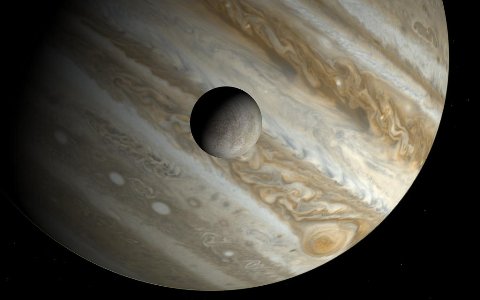
WASHINGTON (PTI): NASA is developing a 'robotic eel' that could explore the icy water of Jupiter's moon Europa and power itself with energy derived from local magnetic fields.
The US space agency has selected 15 proposals for study under Phase I of the NASA Innovative Advanced Concepts (NIAC), a programme that aims to turn science fiction into science fact through the development of pioneering technologies.
"The latest NIAC selections include a number of exciting concepts," said Steve Jurczyk, associate administrator for the Space Technology Mission Directorate (STMD) at NASA Headquarters here.
One of the selected proposals calls for the use of a soft-robotic rover for missions that can not be accomplished with conventional power systems.
This rover would resemble an eel with a short antenna on its back that harvests power from locally changing magnetic fields.
"The goal is to enable amphibious exploration of gas-giant moons like Europa," NASA said.
Another proposal will look at using two glider-like unmanned aerial vehicles connected by an ultra-strong cable at different altitudes that sail without propulsion.
The vehicle would use wind shear in the lower stratosphere (approximately 60,000 ft), similar to a kite surfer, where the upper aircraft provides lift and aerodynamic thrust, and the lower aircraft provides an upwind force to keep it from drifting downwind.
If successful, this atmospheric satellite could remain in the stratosphere for years, enabling NASA's Earth science missions, monitoring capabilities or aircraft navigation at a fraction of the cost of orbital satellite networks.
Employing a novel mobility concept, the Cryogenic Reservoir Inventory by Cost-Effective Kinetically Enhanced Technology (CRICKET) proposal explores volatiles, such as hydrogen, nitrogen and water, stored in permanently shadowed regions on planetary bodies.
Inexpensive robotic crawlers, hoppers and soccer-ball style buckey-bots would explore the surface of these dark regions for water and other compounds.
Multiple bots could be used to develop a high-resolution map to aid in potentially using these resources.
The projects are chosen through a peer-review process that evaluates their potential, technical approach and benefits that can be realised in a reasonable timeframe.
All concepts are very early in the development cycle and represent multiple technology areas, including aircraft propulsion, human life support, science instruments, unique robotic concepts and exploring other diverse technology paths needed to meet NASA's strategic goals.
 Previous Article
Previous Article Next Article
Next Article













The Indian Air Force, in its flight trials evaluation report submitted before the Defence Ministry l..
view articleAn insight into the Medium Multi-Role Combat Aircraft competition...
view articleSky enthusiasts can now spot the International Space Station (ISS) commanded by Indian-American astr..
view article